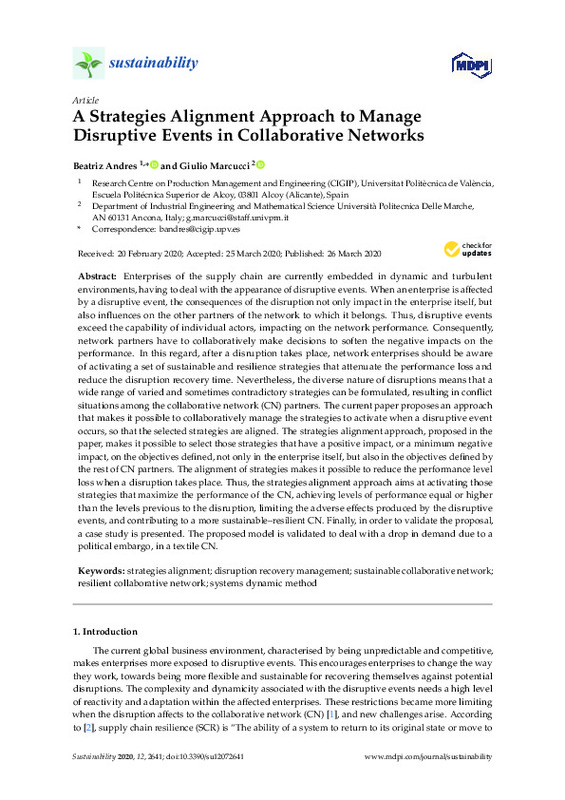Camarinha-Matos, L. M., & Afsarmanesh, H. (2005). Collaborative networks: a new scientific discipline. Journal of Intelligent Manufacturing, 16(4-5), 439-452. doi:10.1007/s10845-005-1656-3
Christopher, M., & Peck, H. (2004). Building the Resilient Supply Chain. The International Journal of Logistics Management, 15(2), 1-14. doi:10.1108/09574090410700275
Andres, B., & Poler, R. (2016). A decision support system for the collaborative selection of strategies in enterprise networks. Decision Support Systems, 91, 113-123. doi:10.1016/j.dss.2016.08.005
[+]
Camarinha-Matos, L. M., & Afsarmanesh, H. (2005). Collaborative networks: a new scientific discipline. Journal of Intelligent Manufacturing, 16(4-5), 439-452. doi:10.1007/s10845-005-1656-3
Christopher, M., & Peck, H. (2004). Building the Resilient Supply Chain. The International Journal of Logistics Management, 15(2), 1-14. doi:10.1108/09574090410700275
Andres, B., & Poler, R. (2016). A decision support system for the collaborative selection of strategies in enterprise networks. Decision Support Systems, 91, 113-123. doi:10.1016/j.dss.2016.08.005
Bevilacqua, M., Ciarapica, F. E., Marcucci, G., & Mazzuto, G. (2019). Fuzzy cognitive maps approach for analysing the domino effect of factors affecting supply chain resilience: a fashion industry case study. International Journal of Production Research, 58(20), 6370-6398. doi:10.1080/00207543.2019.1680893
Chorn, N. H. (1991). The «Alignment» Theory: Creating Strategic Fit. Management Decision, 29(1). doi:10.1108/eum0000000000066
Snyder, L. V., Atan, Z., Peng, P., Rong, Y., Schmitt, A. J., & Sinsoysal, B. (2010). OR/MS Models for Supply Chain Disruptions: A Review. SSRN Electronic Journal. doi:10.2139/ssrn.1689882
Egbelakin, T., Poshdar, M., Walsh, K. Q., Ingham, J., Johnston, D., Becker, J., … Rasheed, E. (2018). Preparation of small to medium-sized enterprises to earthquake disaster. Bulletin of the New Zealand Society for Earthquake Engineering, 51(4), 171-182. doi:10.5459/bnzsee.51.4.171-182
Kimura, N., Hoshino, S., & Onitsuka, K. (2019). Analyzing the Association Between Disaster Risk Preparedness and Environmental Consciousness of Small and Medium-Sized Enterprises: The Case of Sukagawa City, Fukushima Prefecture, Japan. Journal of Disaster Research, 14(8), 1047-1058. doi:10.20965/jdr.2019.p1047
Ivanov, D. (2017). Simulation-based ripple effect modelling in the supply chain. International Journal of Production Research, 55(7), 2083-2101. doi:10.1080/00207543.2016.1275873
Morrish, S. C., & Jones, R. (2020). Post-disaster business recovery: An entrepreneurial marketing perspective. Journal of Business Research, 113, 83-92. doi:10.1016/j.jbusres.2019.03.041
Nair, A., & Vidal, J. M. (2011). Supply network topology and robustness against disruptions – an investigation using multi-agent model. International Journal of Production Research, 49(5), 1391-1404. doi:10.1080/00207543.2010.518744
Kim, Y., Chen, Y.-S., & Linderman, K. (2014). Supply network disruption and resilience: A network structural perspective. Journal of Operations Management, 33-34(1), 43-59. doi:10.1016/j.jom.2014.10.006
Kamalahmadi, M., & Parast, M. M. (2016). A review of the literature on the principles of enterprise and supply chain resilience: Major findings and directions for future research. International Journal of Production Economics, 171, 116-133. doi:10.1016/j.ijpe.2015.10.023
Sanchis, R., & Poler, R. (2019). Enterprise Resilience Assessment—A Quantitative Approach. Sustainability, 11(16), 4327. doi:10.3390/su11164327
Pei, J., & Liu, W. (2019). Evaluation of Chinese Enterprise Safety Production Resilience Based on a Combined Gray Relevancy and BP Neural Network Model. Sustainability, 11(16), 4321. doi:10.3390/su11164321
Blackhurst *, J., Craighead, C. W., Elkins, D., & Handfield, R. B. (2005). An empirically derived agenda of critical research issues for managing supply-chain disruptions. International Journal of Production Research, 43(19), 4067-4081. doi:10.1080/00207540500151549
Reyes Levalle, R., & Nof, S. Y. (2017). Resilience in supply networks: Definition, dimensions, and levels. Annual Reviews in Control, 43, 224-236. doi:10.1016/j.arcontrol.2017.02.003
Rajesh, R. (2018). On sustainability, resilience, and the sustainable–resilient supply networks. Sustainable Production and Consumption, 15, 74-88. doi:10.1016/j.spc.2018.05.005
Jabbarzadeh, A., Fahimnia, B., & Sabouhi, F. (2018). Resilient and sustainable supply chain design: sustainability analysis under disruption risks. International Journal of Production Research, 56(17), 5945-5968. doi:10.1080/00207543.2018.1461950
Mari, S., Lee, Y., & Memon, M. (2014). Sustainable and Resilient Supply Chain Network Design under Disruption Risks. Sustainability, 6(10), 6666-6686. doi:10.3390/su6106666
Kaur, H., & Singh, S. P. (2016). Sustainable procurement and logistics for disaster resilient supply chain. Annals of Operations Research, 283(1-2), 309-354. doi:10.1007/s10479-016-2374-2
Mari, S., Lee, Y., & Memon, M. (2016). Sustainable and Resilient Garment Supply Chain Network Design with Fuzzy Multi-Objectives under Uncertainty. Sustainability, 8(10), 1038. doi:10.3390/su8101038
Ivanov, D. (2017). Revealing interfaces of supply chain resilience and sustainability: a simulation study. International Journal of Production Research, 56(10), 3507-3523. doi:10.1080/00207543.2017.1343507
Barthe-Delanoë, A.-M., Montarnal, A., Truptil, S., Bénaben, F., & Pingaud, H. (2018). Towards the agility of collaborative workflows through an event driven approach – Application to crisis management. International Journal of Disaster Risk Reduction, 28, 214-224. doi:10.1016/j.ijdrr.2018.02.029
Zhu, W., & Wang, Z. (2018). The Collaborative Networks and Thematic Trends of Research on Purchasing and Supply Management for Environmental Sustainability: A Bibliometric Review. Sustainability, 10(5), 1510. doi:10.3390/su10051510
Ivanov, D., Sokolov, B., Solovyeva, I., Dolgui, A., & Jie, F. (2016). Dynamic recovery policies for time-critical supply chains under conditions of ripple effect. International Journal of Production Research, 54(23), 7245-7258. doi:10.1080/00207543.2016.1161253
Sanchis, R., & Poler, R. (2013). Definition of a framework to support strategic decisions to improve Enterprise Resilience. IFAC Proceedings Volumes, 46(9), 700-705. doi:10.3182/20130619-3-ru-3018.00600
AnyLogichttps://www.anylogic.com/
Abylaev, M., Pal, R., & Torstensson, H. (2014). Resilience challenges for textile enterprises in a transitional economy and regional trade perspective - a study of Kyrgyz conditions. International Journal of Supply Chain and Operations Resilience, 1(1), 54. doi:10.1504/ijscor.2014.065459
Li, W.-Y., Chow, P.-S., Choi, T.-M., & Chan, H.-L. (2016). Supplier integration, green sustainability programs, and financial performance of fashion enterprises under global financial crisis. Journal of Cleaner Production, 135, 57-70. doi:10.1016/j.jclepro.2016.06.048
Venkatesh, V. G., Rathi, S., & Patwa, S. (2015). Analysis on supply chain risks in Indian apparel retail chains and proposal of risk prioritization model using Interpretive structural modeling. Journal of Retailing and Consumer Services, 26, 153-167. doi:10.1016/j.jretconser.2015.06.001
Yang, S., Song, Y., & Tong, S. (2017). Sustainable Retailing in the Fashion Industry: A Systematic Literature Review. Sustainability, 9(7), 1266. doi:10.3390/su9071266
Sanctions against Russia and the Russian Embargo: Billions of Euros Damage to ‘Made in Italy’ Productshttp://www.europarl.europa.eu/doceo/document/E-8-2018-002225_EN.html
[-]









